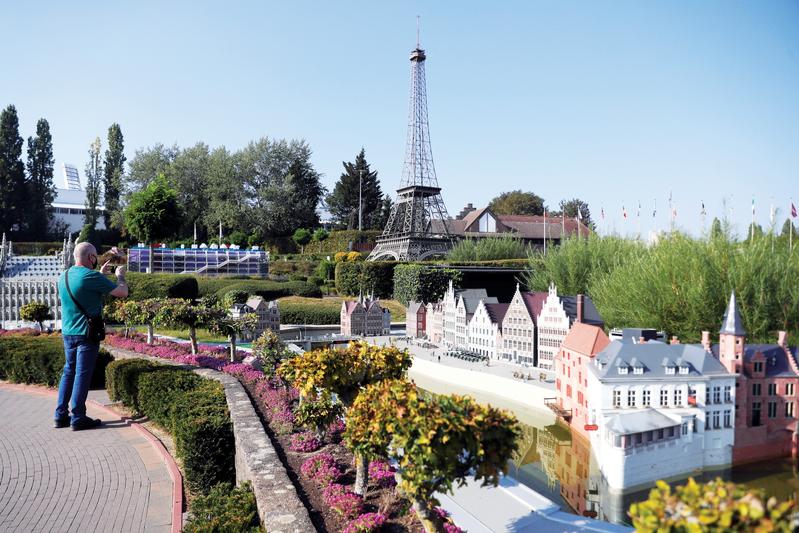 A tourist enjoys his time at a mini-Europe park in Brussels on Sept 22. Restrictions on visits are kept in the park as countries in the continent remain on alert for COVID-19. (ZHENG HUANSONG / XINHUA)
A tourist enjoys his time at a mini-Europe park in Brussels on Sept 22. Restrictions on visits are kept in the park as countries in the continent remain on alert for COVID-19. (ZHENG HUANSONG / XINHUA)
BRUSSELS — The delay of a European Union summit signals a strong comeback of COVID-19 in the continent.
European Council President Charles Michel has decided to put off a summit of EU leaders after going into quarantine on Sept 22, his spokesman said on Twitter.
Earlier the same day, the EU chief learned that a security officer with whom he had previous close contact tested positive for COVID-19, said spokesman Barend Leyts.
Michel himself “is tested regularly and tested negative yesterday (Sept 21),” but decided to enter quarantine abiding Belgian rules, Leyts tweeted.
The in-person summit, originally scheduled for Sept 24-25, was rescheduled for Oct 1-2.
In the week of Sept 10-16, a total of 7,749 infections were reported in Belgium, whose capital plays host to the EU headquarters — a daily average of 1,107 new cases.
Belgium is ending mandatory mask usage outdoors and reducing the period of self-isolation, in a slight easing of restrictions announced on Sept 23 despite sharply rising infection numbers.
Prime Minister Sophie Wilmes said that from Oct 1, people who have had contact with an infected person would only have to quarantine for seven days. Masks would no longer be mandatory everywhere outside, as currently the case in the capital Brussels and some other cities, she said.
“The epidemiological situation is not evolving favorably,” Wilmes said. However, there was no clear tightening of measures.
German Economy Minister Peter Altmaier became the country’s second cabinet member to enter quarantine on Sept 23, writing that he would stay at home after close contact with the aide of another EU minister who had tested positive.
Earlier, Foreign Minister Heiko Maas was forced to cancel a planned trip to Jordan and quarantine himself after one of his bodyguards tested positive for COVID-19. Both ministers have so far tested negative.
On the same day, Germany added regions in 11 European countries to the list of destinations it classifies as coronavirus risk zones. The Robert Koch Institute health agency included the French regions of Centre-Val de Loire, Brittany and Normandy, the coastal region Lika-Senj in Croatia and the upland Primorsko-notranjska region in Slovenia.
France’s health minister unveiled a map of coronavirus “danger zones” around the country on Sept 23 and gave local authorities days to tighten restrictions or risk having a state of health emergency declared.
Olivier Veran said the country would be divided into zones by alert level with Marseille, the second-largest city, and the French Caribbean island of Guadeloupe for now the only two areas put on “maximum” alert level, while Paris, Lille, Toulouse and six other cities were declared “reinforced danger zones”.
Shortly after Veran spoke, French health authorities reported 13,072 new confirmed COVID-19 cases over 24 hours, the daily tally coming in above 13,000 for the third time in six days.
Spain’s Madrid region requested on Sept 23 urgent help to hire hundreds of foreign doctors and reinforce police as they registered 1,290 new infections and considered extending a partial lockdown to more areas.
Representing over a quarter of Spain’s 4,143 new cases in the previous 24 hours, the capital region has been hardest hit by a second wave of COVID-19, with the number of daily deaths and infections soaring to levels not seen since May.
Ignacio Aguado, deputy head of the regional government, said the region needed 300 doctors from outside the European Union. He also asked the central government for an additional 222 national police officers to enforce quarantines and fines in districts now back under partial lockdown.
“We’ve decided to formally request logistical help from the military to install (hospital) tents, carry out tests and disinfection tasks in each of the areas under restrictions,” Aguado also said.
Ireland reported 234 more cases on Sept 23, with two deaths. But the number of new cases in Ireland may double every 12 to 14 days at the current rate, the nation’s health ministry said.
“We are unfortunately seeing continuing increases in all metrics of the disease,” Health Ministry advisor Philip Nolan said.
Xinhua and agencies contributed to this story.


